By Cliff Mass
Reposted from The Cliff Mass Weather Blog
During the past week, the Pacific Northwest experienced the most severe heat event of the past century.
All-time high-temperature records were broken throughout the region, often by large margins. Many in the media, several local and national politicians, and some activist environmental scientists have claimed that this event was “driven by” or predominantly forced by human-inspired global warming (usually referred to as “climate change”).But such global warming claims are not supported by the facts and our best scientific understanding.

Truth and Rigorous Science About Climate Change is Necessary for Wise Decisions
Truth and Rigorous Science About Climate Change is Necessary for Wise Decisions
In this blog, I will use observations, modeling, climatological data, and the peer-reviewed scientific literature to demonstrate that human-caused global warming played a very small role in the extreme heat event that we just experienced here in the Pacific Northwest.I will describe the origins of a meteorological black swan eventand how the atmosphere is capable of attaining extreme, unusual conditions without any aid from our species.As you read this, consider that I have actively pursued research on Northwest heatwaves, published several papers in the peer-reviewed literature on this specific topic, and have run both weather prediction and climate models that simulate such events. This subject is in my wheelhouse.
I also discuss the seriousness of misinformation. You and others can not make wise decisions when the information provided to you is not based on truth and science.



its maximum warmth.
The Event
The maximum temperatures during the heatwave were as high as 30-40 degrees Fahrenheit above normal. Seattle had a high of 108F, 35F above the normal high of 73F. Quilluyte on the Washington Coast zoomed to 109F compared to a normal high of 65 (44F above normal). Throughout the region, all-time temperature records were broken, representing the hottest day on record at many locations.
The map below shows where the all-time temperature records were broken, mainly west of the Cascade crest.
These high-temperature records occurred in late June, which is atypically early in the summer, with previous high-temperature records occurring roughly a month later when the Pacific Northwest climatologically is at its maximum warmth.
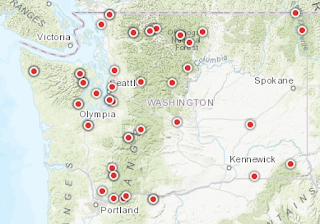

All-Time Records for High Temperatures Broken In WA/OR (red dots)
The Global Warming Background
The Pacific Northwest is warming and human emission of greenhouse gases is probably the origin of much of it.
To illustrate, the figure below shows the annual average high temperatures for Washington State from 1900 through 2020. About 1.5 F of warming over 120 years. The summer warming is nearly the same.
Let us assume that ALL of this warming is caused by mankind’s greenhouse gas emissions, although some might argue with that assumption. The warming during the past several decades is consistent with human causation, and climate modeling supports this contention.
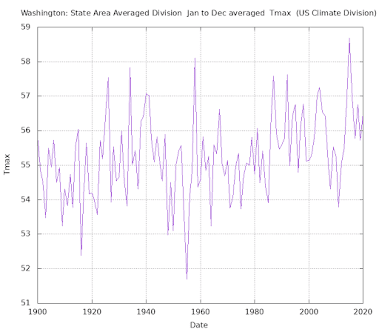
A very good question. Such a ten-times amplification of the global warming signal would require powerful positive feedbacks, which I will demonstrate below are simply not evident. A global warming origin of increased temperature extremes would also be evident in long-term trends of extreme temperatures, but such trends do not exist.But before we get into such things, you must understand the origins of the extraordinarily high temperatures observed earlier last week.
A number of factors came together simultaneously to produce the extreme high temperatures over the Northwest observed last week.
The key factor in this and previous regional heatwaves is the development of an unusually strong and persistent area of high pressure over the Northwest. Such high-pressure areas are also called ridges and often extend vertically through great depth (10-30 thousand feet).
The figure below illustrates what the ridge looked like at 11 AM last Sunday around 18,000 feet above the surface (500 hPa pressure). At this level, the ridge was the most intense ever observed over the region (will prove that later).

Map A
High-pressure areas/ridges are associated with warm temperatures during the summer. First, high-pressure areas possess strong sinking, and sinking causes powerful warming as air is compressed as it descends to the higher pressure that exists at low levels (pressure decreases with height). Your air pump, very warm after inflating a tire, is a good illustration of this mechanism.
Ridges also possess southerly (from the south) flow on their western sides (apparent above), bringing subtropical warmth northwards.
But there is more!
The sinking air in high-pressure areas prevents clouds, thus allowing maximum solar heating (and the sun is near maximum strength now). And on the southern side of upper-level ridges there is often easterly (from the east) wind, which can move down the western slopes of terrain barriers, producing even MORE compressional heating as the air descends the slopes.
It is no accident that every major summer heatwave in our region is associated with a ridge of high pressure. Ridges are veritable heating machines during summer and sometimes are colloquially referred to as heat domes. The media loves this term.
The origin of the intense ridge of high pressure of last week is fascinating.
Our ridge appears to have originated in the far western Pacific, where a tropical disturbance rammed into the Pacific jet stream, causing high-amplitude waviness in the jet stream thousands of miles downstream to the east. The result was a strong ridge over the Northwest, with the waviness also producing a deep trough over the central Pacific (see upper-level map on Wednesday, June 23rd, 500 hPa pressure–about 18,000 ft).

In our heatwave, there was a feature that supercharged the warming west of the Cascade crest and the coastal mountains (e.g., the Olympics): an approaching upper-atmospheric low-pressure area (or trough) that was west of northern California in Map A above.

Our high-pressure ridge (“heat dome”) had a potent supercharger. Picture courtesy of Nick Ares.
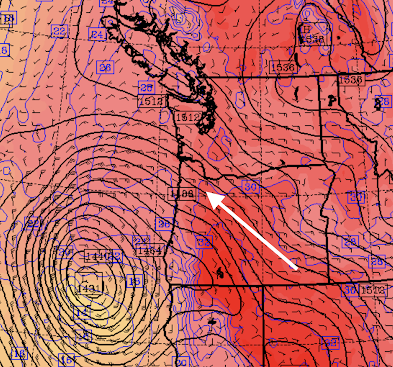
And the impact of the supercharger is seen in the super-warm air (brown colors, 104F, and more) found downstream of the Cascades at 5 PM on Monday, June 28.

Record amplitude of a ridge/high pressure over our region, forced by a tropical disturbance in the western Pacific, that produced a downstream “wave train”. An environment that allowed the resulting wave to amplify. The ridge had to be in exactly the right position relative to our terrain. An upper-level trough had to develop in just the right location offshore and move in the optimal direction to cause strong southeasterly flow, fostering the supercharger noted above. We needed a period when the sun was very strong. And a summer stretch without smoke, which has a profound cooling effect.
The meteorological dice had to come up all sixes. And they did.
It is important to note that the atmosphere comes up sixes regularly, but not necessarily in the same place. The atmosphere is churning with all kinds of variability inherent in the physics of the atmosphere (also called natural variability).
To illustrate this to you, below is a world map of the temperature anomalies (difference from normal) just above the surface (about 800 m in elevation) on Tuesday, June 29th. You can see our extreme heatwave (red colors),\ centered over the northwest corner of Washington.
Those are overwhelming NOT the result of global warming, but of natural variability. I could show you a similar map for a date, in say, 1940. It would look the same (I checked).
Extreme temperatures happen all the time in a somewhat random fashion. They just don’t happen where YOU are located very frequently, because so many random mechanisms must come together at the same time to do so.
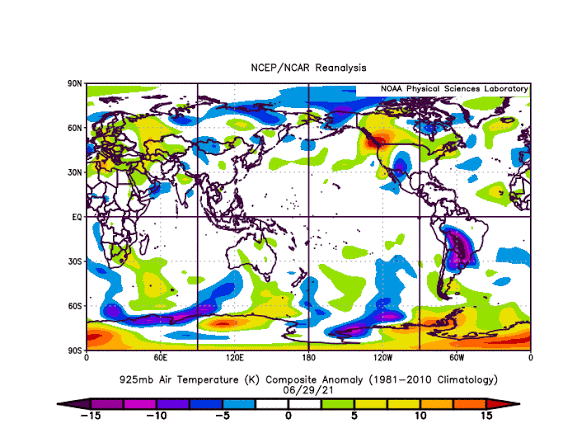
Natural Variability or Global Warming? Dealing with Unsupported Claims
Since global warming is much smaller than the magnitude of the heatwave temperature extremes observed last week in the Northwest, those trying to ascribe the extreme temperatures to global warming must prove that global warming somehow amplifies natural variability.
For example, some have suggested that the key feature of last week’s heatwave– the extreme amplitude ridge of high pressure aloft– had origins in global warming. Others have suggested that global warming dries the soils, resulting in less evaporative cooling and warmer temperatures, thus explaining the extremes.
We will evaluate the plausibility of these various mechanisms for amplifying global warming and will show that they can not explain what happened last week.
Does Global Warming “Drought” and Dry Soils Explain the Heatwave?
One hypothesis starts with global warming causing drought and dry soils over our region. Then they claim that such dry soils warm the air (less evaporative cooling) enough to explain the high temperatures. Others suggest that the drought increases high pressure as well.
For reference, the NOAA Drought Monitor graphic for June 22nd shows normal or just slightly dry conditions west of the Cascade crest (where the extreme records were broken), but “drought” conditions over the normally dry region of eastern Washington.
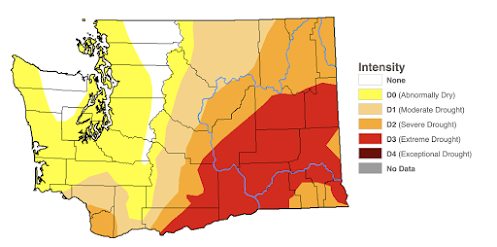
The claims that the critical extreme ridge of high pressure was caused by dry conditions east of the Cascade crest are problematic for many reasons, including the fact that the origin of the high pressure can be traced to a large-scale amplification of the wave pattern over the entire North Pacific. Similarly, the claims that dry conditions east of the Cascades were significant in creating the extreme heatwave west of the Cascade crest are also weak. Let me prove this to you.
Model forecasts were stunningly good for this event. Even almost a week out, model simulations correctly predicted the development of an extreme high-pressure area over the Northwest and very high surface temperatures. Modelers like myself can “play god” with such excellent simulations, in this case, by making the soil much moister and seeing what happens. Would the heatwave go away with the absence of drought and under moister soil moisture conditions? You are about to find out.
Senior UW graduate student Robert Conrick re-ran the UW WRF weather forecasting model and tripled the soil moisture everywhere. He turned the region into a veritable swamp! And what do you think happened to the ridge of high pressure and the heat dome? Did it disappear? Did the heatwave go away?
The answer: virtually nothing happened to the intense high-pressure area. The heat dome was essentially unchanged. Surface temperatures over BC and western WA hardly changed.
The figure below shows the height of the ridge at 500 hPa pressure (you can think of this as the pressure at around 18,000 ft. The left side uses the actual soil moisture last week, the right side shows the same thing with TRIPLE the soil moisture. Virtually the same heights or pressures.

What about temperatures at the surface? Even with “biblical” moistening of the soil over the entire domain, temperatures over western Washington and British Columbia, where the heatwave was most severe, hardly changed, cooling by about 1 degrees C (about 2F) or less.
The theory of an unusually dry surface produced by global warming “drought” causing the high pressure “heat dome” or greatly warming low-level temperatures west of the Cascade crest appears unfounded.
This makes physical sense for a number of reasons. For example, the lush western side of the Northwest remained relatively moist into the summer. June’s rainfall was well above normal over most of the region west of the Cascade crest. As noted in my earlier blog, the trajectories of the air reaching the surface west of the Cascade crest did not come from the surface over eastern Washington or Oregon but subsided (sank) rapidly from aloft.
But there is something else that essentially puts the silver stake into the heart of the unfounded global warming “drought” theory of this event.
Specifically, there is no observed trend towards “drought” over the Pacific Northwest as demanded by the proposed global warming origin of this event.
Below is the observed annual precipitation over Washington State since 1900. Our region is NOT getting drier. If anything precipitation has increased a slight amount.

And is spring drought increasing in frequency as suggested by those pushing the global warming hypothesis? The answer is no. Below is a long-period plot of the Palmer Drought Index, which considers BOTH temperature and precipitation. No apparent long-term trend in spring drought…and notice how much worse it was during the 1930s and early 1940s.
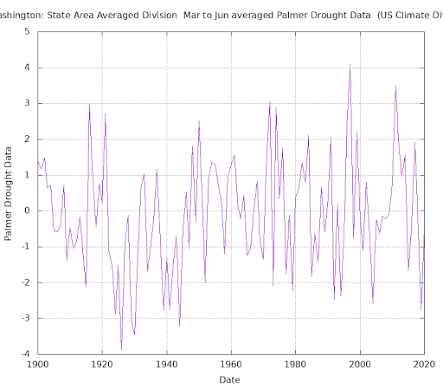
So not only does the global warming drought hypothesis for the heatwave fail on a physical basis, but there is no trend in drought, which is a requirement if global warming was the explanation.
Does Global Warming Produce Stronger Ridges of High Pressure?
Another claim, provided by Professor Michael Mann of Penn. State and published in the New York Times is that global warming produces a weakened, “lazy” jet stream that forces more wave-like undulations and thus more ridging. This hypothesis has been thoroughly debunked in a number of papers in the peer-reviewed literature (see this article for an example or my blog). But I need not cite others, since I and my students have investigated this very issue in research sponsored by the National Science Foundation and published the research in the peer-reviewed literature.
For example, Matt Brewer and I looked at global climate models driven by rapidly increasing greenhouse gases and found that high-pressure areas like that seen last week will WEAKEN under global warming. Just the opposite of what Professor Mann was suggesting.

And last week I examined the frequency of high-amplitude ridging over our region from 1948 to today using NOAA reanalysis gridded data. I found no trend in the extreme highs aloft.

As further confirmation, Dr. Joe Zagrodnik of Washington State University examined the radiosonde sounding data (balloon-launched weather stations) at Quillaytate on the Washington coast and found no upward trend in the maximum heights (that is big ridges of high pressure) at 500 hPa (around 18,000 ft) at that location.
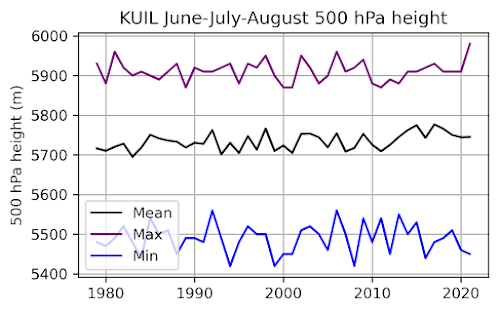
Dr. Zagrodnk also did not find any trend in extreme high temperatures in the lower troposphere (around 5000 ft).
Bottom line: none of the claims that global warming increases ridging (high pressure) over time are supported by data or modeling. Unfortunately, Dr. Mann and others continue to push this unfactual narrative.
Perhaps, The Most Compelling Evidence of All
If global warming was producing extreme heatwaves in our region, such as the event last week, there would be a long-term trend towards more extreme high temperatures. A single event does not reflect climate, only a trend or changes in long-term average do.
Well-known climatologist (and the official Alabama State climatologist) Dr. John Christy has run the numbers to determine if there are trends in record-breaking extreme temperatures in Washington State or Oregon.
As shown below, there IS NO INCREASING TREND for more record high temperatures over our region during the past century.
In fact, the past decade (2011-2020) had no all-time records. I suspect many of you are surprised at this, but it is true.

Total number of stations with temperatures about 99F in our region? Also no trend
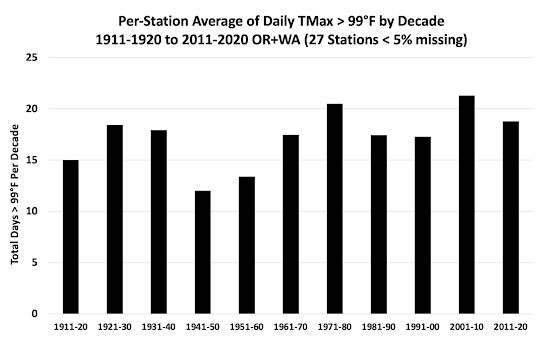
These results are consistent with what others have found. For example, the U.S. National Climate Assessment found the warmest day of the year over the Northwest actually COOLED between a historic (1901-1960) and a contemporary period (1986-2016).

There are a number of possibilities. For example, natural variability may be so dominant that a small amount of global warming is hard to notice. Or there may be climate feedbacks that work against extremes in a warming world….at least in our area. I have been researching one of these feedbacks: the tendency of heat-wave producing easterly flow to weaken under global warming and describe it below. And I can think of several more.
One of my major research projects (with Professor Eric Salathe of UW Bothel and supported by Amazon) has been to run high-resolution climate simulations driven by the most realistic global climate models. And the results are very relevant for this discussion.
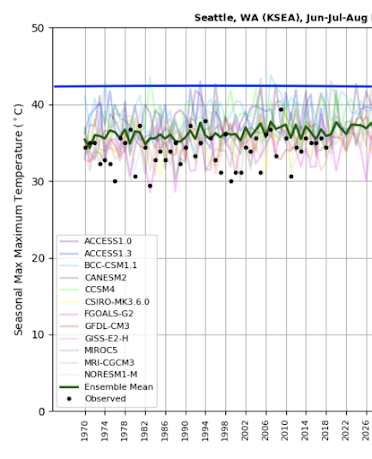
First, and of great importance, there is little upward trend in the extreme high temperatures.
Second, the most extreme temperatures of the ensembles over the entire period climbed to about 42C (108F). To do so, required rare, but possible, combinations of several factors. Improbable, but possible. You might also notice that the climate model was typically about 1-2C to warm. I believe that reflects the inability of even my very high-resolution simulations to properly simulate the effects of a narrow, improperly resolved cold Puget Sound.
Most people assume that global warming can only increase our high temperatures, but it can do the opposite as well. The Northwest’s mountains and nearby cold water paradoxically might reduce heatwaves over the populated areas west of the Cascade crest under global warming.
Global warming preferentially warms the interior of western North America compared to the Pacific coast (land warms up much more quickly than the Pacific Ocean). The heating results in enhanced pressure falls over the interior (warm air is less dense than cold air), which strengthens cool, onshore flow and lessens warm easterly (offshore) flow. Bad for heatwaves!
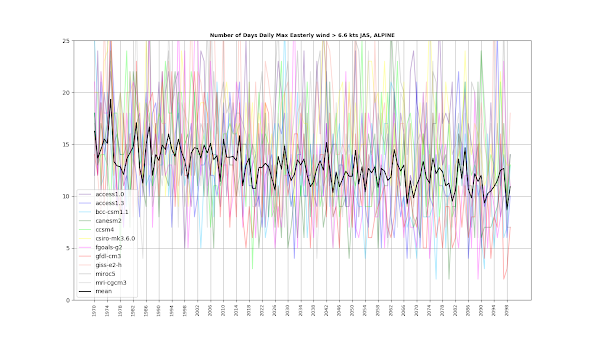
The Evidence is Overwhelming
As I described above, the natural origins of the “black swan” heatwave we experienced last week can be demonstrated in a number of independent ways, from examining the origins and frequency of the ingredients (such as the high-amplitude ridge of high pressure), considering the statistics of warm temperatures (the lack of trend in extreme high-temperature days), and through high-resolution climate modeling.

The inaccurate information being distributed about the origins of this heatwave is very disturbing.
Some of this is being done out of ignorance or laziness, but a few individuals are deceiving the public deliberately. Science journalism is only a shadow of what it was decades past, and a number of scientists now see social activism as more important than the determination and communication of truth.

